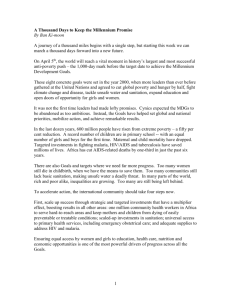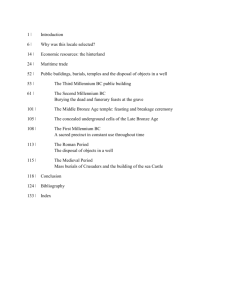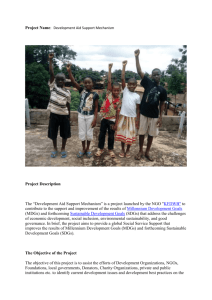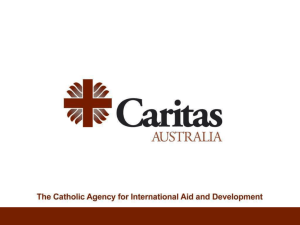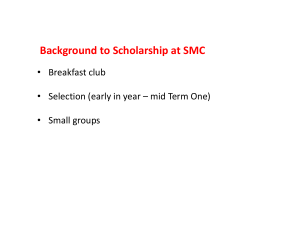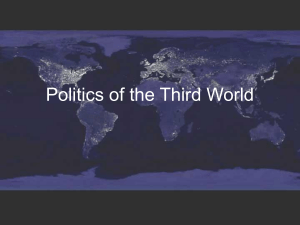Presentation
advertisement
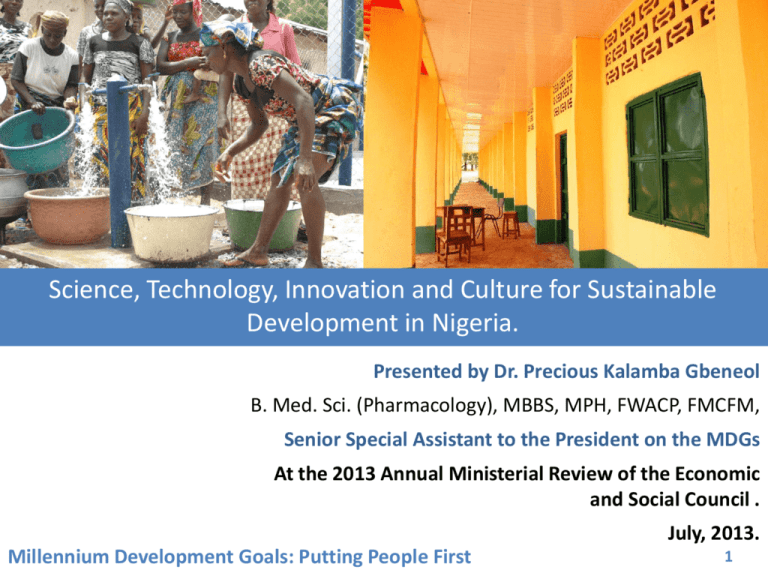
Science, Technology, Innovation and Culture for Sustainable Development in Nigeria. Presented by Dr. Precious Kalamba Gbeneol B. Med. Sci. (Pharmacology), MBBS, MPH, FWACP, FMCFM, Senior Special Assistant to the President on the MDGs At the 2013 Annual Ministerial Review of the Economic and Social Council . July, 2013. Millennium Development Goals: Putting People First 1 Outline • Where are we on the MDGs? • What are the innovations driving MDGs progress in Nigeria ? • How have we harnessed the potential of science, technology innovation and culture for socio-economic transformation? • How have we mainstreamed sustainable development into national development strategies? • What are the emerging national challenges that need priority attention from governments and other key stakeholders? Millennium Development Goals: Putting People First 2 MDG 1: Eradicate Poverty and Extreme Hunger Prevalence of Underweight Children Under Five Years of Age 2008 2011 2012 25.00% 2015 20.00% 27.40% 23.10% Proportion of the Population Suffering from Hunger 19.31% 24.20% 15.00% 17.85% 10.00% 8.26% 9.66% 5.00% 0.00% 1991 2008 2011 2012 2012 2015 2015 Millennium Development Goals: Putting People First 3 MDG 2: Universal Basic Education Net Attendance Ratio in Primary School 120% Literacy Amongst 15 - 24 Year Old Women 120% 100% 100% 80% 62.10% 70.10% 80% 71% 60% 60% 40% 40% 20% 20% 0% 0% 2008 2011 2012 2015 100% 100% 64.30% 65.60% 66% 2008 2011 2012 Millennium Development Goals: Putting People First 2015 4 MDG 3: Promote Gender Equality and Empower Women Ratio of Girls to 100 Boys in Primary School 1990 2008 2012 100 Ratio of Girls to 100 Boys in Secondary School 2015 1990 100 85.4 76 1990 75 2008 2012 2008 2015 1990 Millennium Development Goals: Putting People First 2012 2015 102 100 2012 2015 79.9 2008 5 MDG 4: Reduce Child Mortality Infant Mortality Rate (per 1,000 Live Births) 120 Under 5 Mortality Ratio (per 1,000 Live Births) 180 97 100 160 157 158 140 80 75 120 61 94 100 60 80 40 30 64 60 40 20 20 0 0 2008 2011 2012 2015 Millennium Development Goals: Putting People First 2008 2011 2012 2015 6 MDG 5: Maternal Mortality Percentage of Births Attended by Skilled Health Personnel 90% 78.75% 80% Maternal mortality rate (per 100,000 live birth) 70% 800 60% 48.70% 50% 40% 53.60% Per 100,000 live births 38.90% 545 350 250 30% 2004 20% 2008 2012 2015 10% 0% 2008 2011 2012 2015 Millennium Development Goals: Putting People First 7 MDG 6: Combat HIV/AIDS, Malaria, & Other Diseases Percentage of Children Under Five Sleeping Under ITN 150% 100% 100% 50% 5.50% 34.60% 0% 2008 2012 Millennium Development Goals: Putting People First 2015 8 MDG 7: Water & Sanitation Percentage of Population Using Improved Sanitation Facility, Urban and Rural (de jure Population) Percentage of population using improved drinking water source, urban and rural (de jure population) 80% 90% 77% 80% 70% 60% 55.80% 58.50% 69.50% 70% 60% 57% 50% 50% 40% 40% 31.20% 33.70% 2008 2012 30% 30% 20% 20% 10% 10% 0% 0% 2008 2011 2012 2015 Millennium Development Goals: Putting People First 2015 9 MDG 8: Develop a Global Partnership for Development Debt service as a percentage export of goods and services (2000 – 2011) 18.0 16.0 14.0 12.0 10.0 8.0 6.0 4.0 2.0 0.0 2000 2001 2002 2003 2004 Telephone Lines (%) 2005 2006 30.0 2007 2008 2009 2010 2011 Internet Users (%) 60 25.0 50 40 20.0 30 15.0 20 10 10.0 0 1990 2000 2001 2002 2003 2004 2005 2006 2007 2008 2009 2010 2011 5.0 Fixed Telephone lines per 100 population Cellular phone subscribers per 100 population 0.0 1990 2000 2001 2002 2003 2004 2005 2006 2007 2008 2009 2010 2011 Millennium Development Goals: Putting People First 10 Key Drivers and Bottlenecks What are the key drivers? • Improved policy environment • Improved economic performance • Better collaboration among actors • Adapting Science Technology and Innovation (STI) to improve MDGs interventions • The disbursement of the DRGs continues to play a critical role. What are the key bottlenecks? • Unequal leadership commitment. • Weak involvement of beneficiaries. • Cultural and behavioural challenges • Climate change • Emerging security challenges Millennium Development Goals: Putting People First 11 Debt Relief Gains Implementation (DRGs): Total Dollar Appropriation Across Time 2006 - 2012 DRG Appropriation Totals in Dollars The implementation $1,000 $900 of the DRGs as $800 additional funding to the $700 traditional $600 Total, annual budget(Dollars, $500 Millions) highlights $400 Nigeria’s $300 commitment to $200 the MDGs $100 framework with demonstrable $0 2006 2007 2008 2009 2010 2011 2012 impact at the Year grassroots. 12 Millennium Development Goals: Putting People First MDGs/DRGs Capital Supplementation Appropriations Across 2006-2012: Line Chart Billions 50 Conditional Grants Scheme 45 40 Monitoring & Evaluation 35 Quick win 30 Communications 25 Special Presidential Interventions 20 MDGs Special Projects 15 Consultancies and Short-term surveys 10 5 Support to UNDP Millennium Campaign 0 2006 2007 2008 2009 2010 2011 Millennium Development Goals: Putting People First 2012 13 MDGs/DRGs Appropriations to MDAs Across 2006-2012: Line Chart Billions 30 Education Health Youth Development 25 Women Affairs Agriculture 20 Water Resources Social Safety Nets Lands, Housing & Urban Development 15 Environment Power Works 10 FCT Defence 5 Police Capacity Building Science and Technology 0 2006 2007 2008 2009 2010 2011 Millennium Development Goals: Putting People First 2012 Petroleum 14 Implementation of the Debt Relief Gains: Conditional Grants Scheme In addition to the impact generated from the CCT scheme, some examples from the • In 2011, around 26% of the population benefitted from the CGS. CGS are revealing: 1. More than 2,844 primary health care facilities were rehabilitated or constructed 2. 6,673 health workers trained 3. More than 74,000 primary school teachers recruited 4. Over 2.4 million insecticide-treated nets (ITNs) provided 5. 3,524 small town boreholes with solarpowered pumps 6. 6,031 boreholes with hand pumps 7. 393 small town water supply schemes constructed 8. 3,709 VIP toilets constructed 9. 7,673 people trained on vocational skills. • About 28.4 million people are benefiting from the investment in primary care through the CGS. • Interventions in water and sanitation also benefits about 8.85 million people. • At least 213,437 benefitted from the skills acquisition programmes. • There is still room for substantial improvement in coverage, usage, access by the target groups and quality of facilities. Millennium Development Goals: Putting People First 15 Planning and Targeting of Investment The CGS targets those with the greatest need. We deployed Science, Technology and Innovation to conduct the following in order to reach the most disadvantaged in society: 1. Poverty Mapping 2. Baseline Facility Inventory 3. Needs Assessment • Findings of Needs Assessment reveal that $78 per capita per year is needed to attain the MDGs by 2015 in Education, Health, Agriculture and Water & Sanitation sectors. Millennium Development Goals: Putting People First 16 An Example of a Poverty Map Millennium Development Goals: Putting People First 17 Ekiti South-West: Overview from Baseline Millennium Development Goals: Putting People First 18 Location of Facilities in the LGA Millennium Development Goals: Putting People First 19 Conditional Cash Transfer (CCT) through e-registration and e-payment Structure 24 States – N10Bn (50% counterpart contribution from States) will go to extreme poor households with children 0-15 years & pregnant women. • 56,500 households receive N5,000 per month for 12 months. They undergo agro-business training during the program and receive N100,000 at exit to aid in enterprise start-up. • Science, Technology and Innovation deployed through e-payment and e-registration Criteria for Selection Human Capacity Development Index broken down to state level, Needs Assessment, Baseline Facility Inventory and Poverty Mapping were used • Five poorest LGAs, five poorest wards in the LGAs with the selections of the poorest households within the wards. • Sim cards and mobile phones bought for all beneficiaries Millennium Development Goals: Putting People First 20 Enhancing Citizen Engagement in Accelerating the Attainment of the MDGs in Nigeria • OSSAP – MDGs in collaboration with UNDP, with support from the Democratic Governance Thematic Trust Fund (DGTTF), is implementing a project titled enhancing citizen engagement in accelerating attainment of the MDGs in Nigeria. • It aims to strengthen and develop tools and mechanisms that would ensure communities’ voice is part of decision making • Feedback is submitted from beneficiary communities on the performance of MDGs interventions across the country through SMS, Email, or a Web Form into a central database at www.mdgs.gov.ng/community Millennium Development Goals: Putting People First 21 Other policy and institutional innovations driving progress on the Internationally Agreed Development Goals (IADGs) 1. Nigeria strengthened coordination through the Joint Planning Board, the National Economic Council and the National Economic Management Team 2. Establishment of an Excess Crude Oil Account (now replaced by the Sovereign Wealth Fund) and promulgating the Fiscal Responsibility Legislation to ensure transparency 3. Revamping the 23 Industrial Development Centres (IDCs) 4. Establishment of the National SMEs Credit Guarantee Scheme to facilitate easier access of SMEs to credit 5. Implementation of the Universal Basic Education (UBE) programme to make funds available for interventions in primary and early secondary school education 6. Free Basic Health programmes especially for Children less than 5 years and pregnant women by State Governments, OSSAP-MDGs and other partners 7. Liberalization of the telecommunication sector, etc. Millennium Development Goals: Putting People First 22 Science Technology and Innovation for socio-economic transformation •Nigeria had its first National Science and Technology (S&T) Policy in 1986 while the current policy commenced in 2012. •The institutional framework for planning and managing Science, Technology and Innovation in Nigeria is coordinated by The Federal Ministry of Science and Technology (FMST). •The establishment of the National Biotechnology Development Agency (NABDA) in November 2001 has contributed to socio-economic transformation in a number of ways. •The National Agency for Science & Engineering Infrastructure (NASENI) has aided socioeconomic transformation. Millennium Development Goals: Putting People First 23 Maximizing the Benefits of Culture and the Creative Sector In June 1999, Federal Ministry of Culture and Tourism established: • The Ministry built 12 Cultural Industrial Centres in the six geo-political zones. The centres provide physical infrastructure to enable cultural activities thrive and serve as a one-stop shop for cultural goods and services. • The country has a movie industry worth $500 million, creating some 200 videos for the home video market every month. The products from Nollywood have become a major source of export to various parts of the world. • Government recently began disbursing grants to movie-makers to boost investment in Nollywood Millennium Development Goals: Putting People First 24 Threat of Flooding in Nigeria Nigeria witnessed an unprecedented flood that affected several states of the Federation in 2012. • The flood seriously affected 14 states in terms of its intensity and impact. • In these 14 states, 395,631 households in 116 out of 291 LGAs were severely affected. Millennium Development Goals: Putting People First 25 Interventions to Tackle the Threat of Flooding in Nigeria 1. Immediate evacuation of the affected population away from the flooded areas. Relocation of the affected population in temporary shelters/accommodation including relocation of pupils to other schools. Development of a consolidated Internally Displaced Persons (IDPs) register Provision of food and non-food items, medical and other humanitarian assistance. Repair of roads to link cut-off towns/settlements. 6. The Federal Government in collaboration with development partners carried out the national 2012 Flood Post-Disaster Needs Assessment 2. (PDNA). 7. The Federal Ministry of Environment with support from development partners like the UNDP developed the flood early warning system and tools 3. to forecast occurrence of flood five days in advance in about 600 communities. 4. 8. The National Emergency Management Authority (NEMA) in collaboration with UNDP has developed the draft 5. Action Plan on Disaster Risk Reduction as well as identification and monitoring of risks. 26 Millennium Development Goals: Putting People First Tackling Environmental Challenges in Nigeria Specific policies and action plans to address environmental challenges that have been put in place include: 1. National Policy on Drought and Desertification; 2. Drought Preparedness Plan; 3. National Policy on Erosion, Flood Control and Coastal Zone Management; 4. National Environmental Sanitation Policy and Action Plan; 5. National Policy Guidelines on Solid Waste Management, Market and Abattoir Sanitation, Excreta and Sewage Management, Sanitary Inspection Premises and Pests and Vector Control; 6. National Forest Policy; 7. National Biodiversity Strategy and Action Plan; 8. National Healthcare Waste Management Policy/Action Plan and Guidelines. Millennium Development Goals: Putting People First 27 Conclusion • The Federal Republic of Nigeria is committed to the realization of the MDGs and other Internationally Agreed Development Goals. • Nigeria’s Vision 20:2020 aims at optimizing the country’s human and natural resources to achieve rapid, sustained economic growth, translating such growth into inclusive, equitable and sustainable development for Nigerians. • Going forward, Government is committed to an STI-based development framework which delivers the needed critical socio-economic transformation to all without leaving anyone behind. Millennium Development Goals: Putting People First 28 Thank you for your attention! Millennium Development Goals: Putting People First 29
